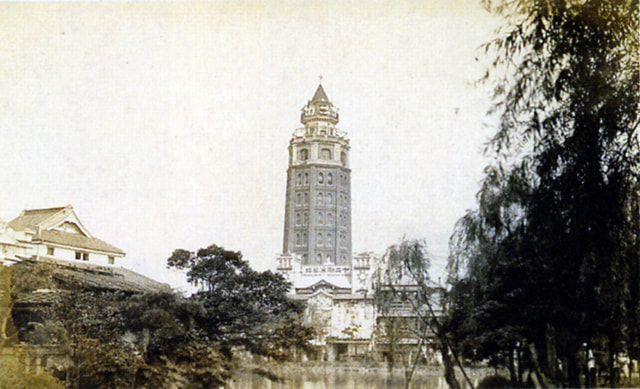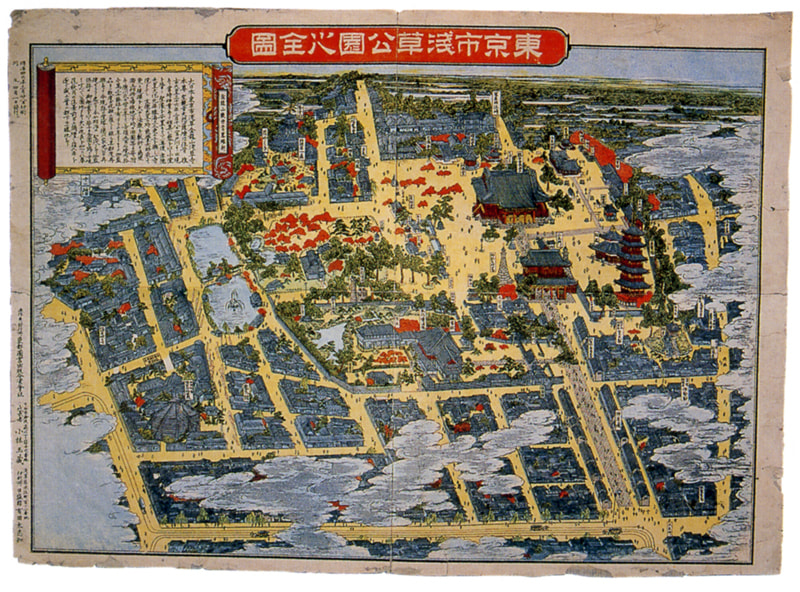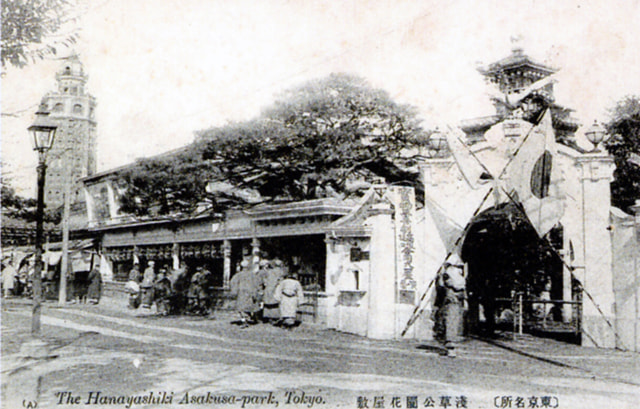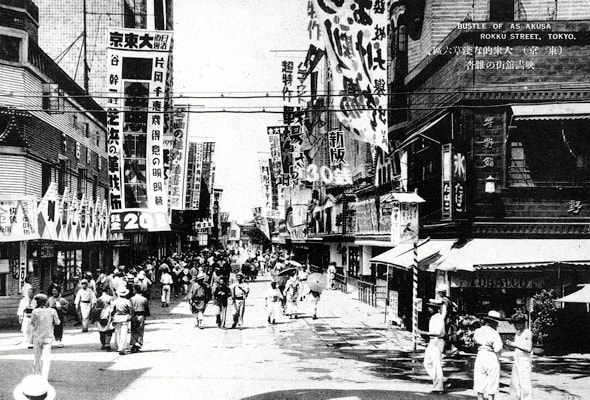
The bustle of Asakusa Rokku movie district in around 1933. The name of Chiezo Kataoka is seen on the picture.
Asakusa has been crowded with people seeking entertainment since the Edo Period. The precincts of Sensoji Temple was designated as a park in 1873. Then, it was divided into six blocks in 1884, and many show houses moved to the sixth block located to the west of Sensoji Temple. Subsequently, the block flourished as a show district where visitors could enjoy acrobatic shows, moving pictures, Asakusa Opera and others. Amusement facilities, including Fujisan Juran-jo, Panorama-kan and Ryoun-kaku (twelve-story building), were built one after another around the sixth block. One of the most noticeable facilities was Hanayashiki which opened during the Kaei era (1848-54). Although, at first, it just displayed seasonal flowers as a botanical garden, a variety of show houses and a zoo were built in the grounds in the Meiji Period, attracting many visitors.
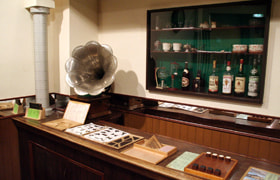
Coffeehouses were full of the Western modern spirit, in which Mobo, or modern boys, and Moga, or modern girls, got together. The western-style interior reflects the stylish trend at that time.
Asakusa Opera swept the country in the Taisho Period. It was a popular entertainment which did not use difficult terms and could be enjoyed at low prices. Many opera companies were established, and many operas were regularly performed in theaters, including Asakusa Sanyukan, Nihonkan, Kannon Gekijo, Kinryukan. Seen on the right of the exhibits are a program of "Casino Folie," a theatrical group, and pictures of Kenichi Enomoto, who was a core member of the group.

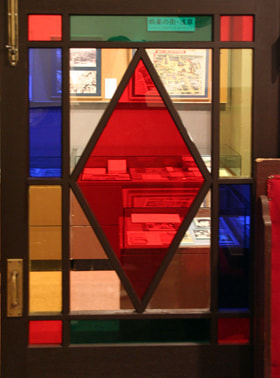
A coffeehouse's door (reproduction) reflects the bustle at that time. Since waitresses wearing aprons served male customers in coffeehouses at that time, it is also said that coffeehouses were examples of "erotic, grotesque and nonsense" that was a tendency at that time. It might coincide with the present-day situation.
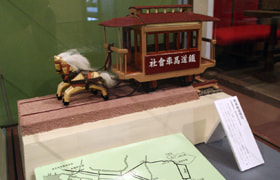
Japan's first railway opened between Shinbashi and Yokohama in 1872, and Ueno Station opened in 1883 as a north gateway to Tokyo. Meanwhile, a horse tramway appeared as an urban transportation facility for common people. The tramway was used for about 20 years since its opening in 1882. Later, the railway tracks were diverted to the use of trolley cars.
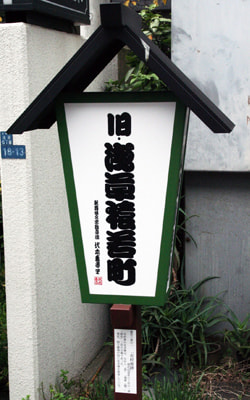
Site of Ichimura-za
"Ichimura-za," one of the Sanza Kabuki theaters in Edo, was relocated from Nihonbashi to Asakusa Saruwaka-cho during the Tempo reforms. Later in 1892, the theater moved to Shitaya Nichomachi. Kikugoro Onoe V, Otojiro Kawakami and other actors performed in this successful theater. Kikugoro VI and Kichiemon Nakamura made spectacular showings in the theater during the Taisho Period. The theater was burnt down after the Kanto Great Earthquake and then rebuilt. However, it was burnt down again in 1932, and ended its long history. The regular draw curtain of Ichimura-za consisted of three colors, from left to right: black, yellow-green and dark orange. Currently, the National Theater of Japan uses the same curtain. (present-day Asakusa 6-chome)
Asakusa Ryoun-kaku (twelve-story building) was designed by British engineer William Kinnimond Burton, and opened in 1890. When it opened, it is said that the building was about 67 meters high. Although the actual survey conducted at the end of the Meiji Period revealed that the building was about 52 meters high, it was the tallest building in Japan at that time. An elevator was installed in this building for the first time in Japan. Ryoun-kaku was known familiarly as a symbol of Asakusa, but it was destroyed due to the Kanto Great Earthquake in 1923. (Photograph: Taisho Period)

Hanayashiki in the late Meiji Period. "Okuyama-kaku," seen on the right in the background, was a five-story tower, which was transferred in 1888 from the grounds of a wealthy merchant's house in Honjo. Ryoun-kaku is seen on the left in the background. The caption written in English is really chic. (Photograph: late Meiji Period)

Map of Tokyo City Asakusa Park (1905)
Illustrated here is Asakusa Park at that time, including Ryoun-kaku, Panorama-kan, show district, Hanayashiki and Nakamise. A horse tramway is seen in the foreground of the map.


Site of Ichimura-za
"Ichimura-za," one of the Sanza Kabuki theaters in Edo, was relocated from Nihonbashi to Asakusa Saruwaka-cho during the Tempo reforms. Later in 1892, the theater moved to Shitaya Nichomachi. Kikugoro Onoe V, Otojiro Kawakami and other actors performed in this successful theater. Kikugoro VI and Kichiemon Nakamura made spectacular showings in the theater during the Taisho Period. The theater was burnt down after the Kanto Great Earthquake and then rebuilt. However, it was burnt down again in 1932, and ended its long history. The regular draw curtain of Ichimura-za consisted of three colors, from left to right: black, yellow-green and dark orange. Currently, the National Theater of Japan uses the same curtain. (present-day Asakusa 6-chome)


Map of Tokyo City Asakusa Park (1905)























